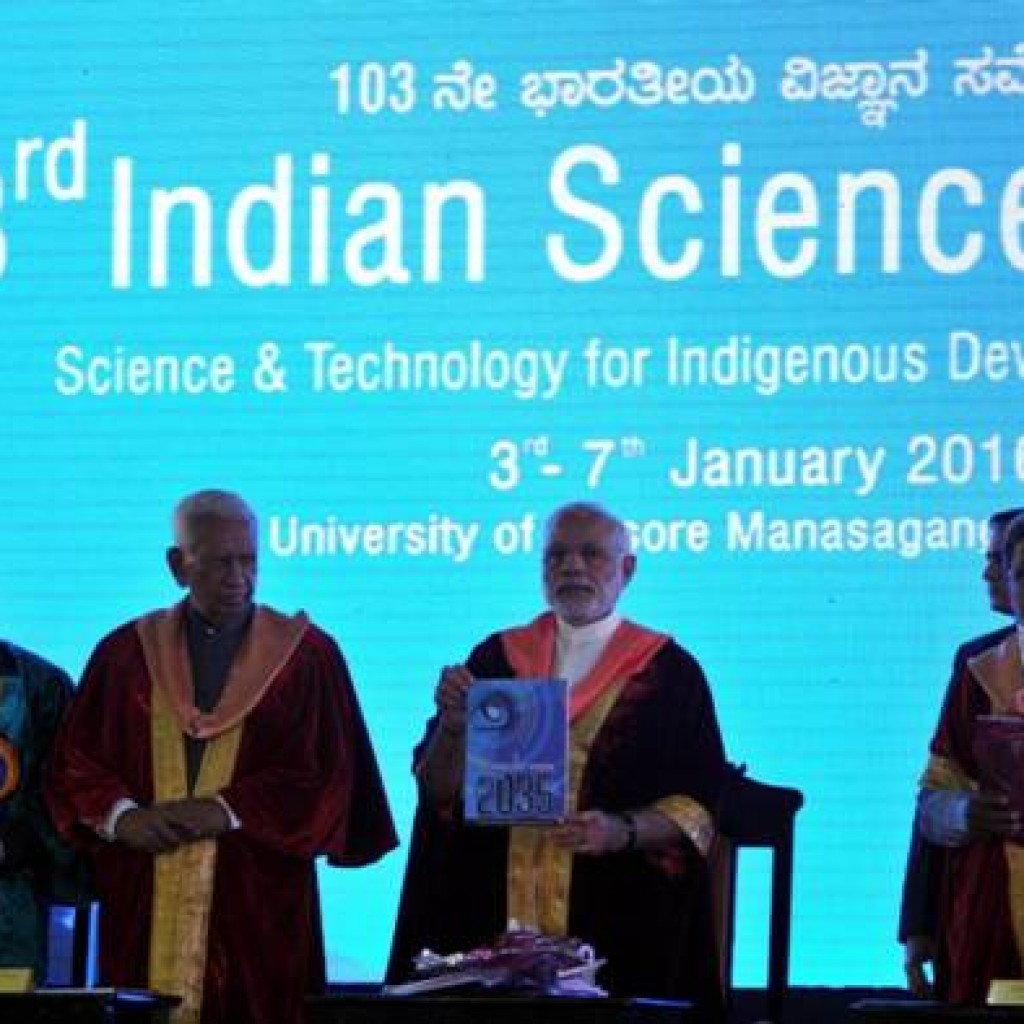Technology Vision 2035 – Putting Science to Use

The Prime Minister in his foreword to the document hoped that the 12 Sectoral Technology roadmaps being prepared by Technology Information, Forecasting and Assessment Council, (TIFAC), which is also the author of this ‘Technology Vision 2035’ document, would excite our scientists and decision makers. He also said “India will be the country of young for the next few decades. It is imperative that every youth blossoms to his/her full potential and that the potential is fully tapped for the benefit of the nation. This in turn requires that needs of our children and youth for nutrition, health, knowledge, skill, connectivity and identity are met. Sh. Narendra Modi had called upon the intelligentsia, Universities and think tanks to actively work for fulfilling the vision”. After unveiling this document, in his speech Sh. Modi said that his government intends to integrate Science & Technology into choices it makes and strategies that it pursues.
The 12 identified sectors of Vision Document are:
Education
Medical Sciences & Healthcare
Food and Agriculture
Water
Energy
Environment
Habitat
Transportation
Infrastructure
Manufacturing
Materials
Information and Communication Technology
Roadmaps, when prepared, will be presented to the Government of India and they would lead for further adoption of technologies in those sectors.
The document says that as technology is for empowering individual citizens, it will empower the country as well.
The Aim of this ‘Technology Vision Document 2035’ is to ensure the Security, Enhancing of Prosperity, and Enhancing Identity of every Indian, which is stated in the document as “Our Aspiration” or “Vision Statement” in all languages of the 8th Schedule of the Constitution. The Vision documents also identifies twelve (12) prerogatives- (six for meeting individual needs and six for the collective needs) that should be available to each and every Indian. These are:
Individual Prerogatives:-
Clean air and potable water
Food and nutritional security
Universal healthcare and public hygiene
24×7 energy
Decent habitat
Quality education, livelihood and creative opportunities
Collective Prerogatives:-
Safe and speedy mobility
Public safety and national security
Cultural diversity and vibrancy
Transparent and effective governance
Disaster and climate resilience
Eco-friendly conservation of natural resources

Assurance of these prerogatives, according to the Vision document, is the core of technology vision for India. For assuring these prerogatives, technologies are mapped as: 1) those readily deployable, 2) those that needs to be moved from Lab to Field, 3) those that require targeted Research and 4) those that are still in Imagination. The last of these category of technologies could come about as a result of curiosity driven or paradigm- shattering ‘Blue-sky’ Research like on Internet of Things, Wearable Technology, Synthetic Biology, Brain computer Interface, Bio-printing and regenerative medicine. Precision agriculture and robotic farming, vertical farming, interactive foods, autonomous vehicles, Bioluminescence, 3D printing of buildings, earthquake prediction, weather modification technologies, green mining etc are some other such technologies expected that would go a long way in sustainably fulfilling the needs of the present and future generations of mankind.
To illustrate such mapping here is the table of categorization of various technologies for meeting the need of ‘Clean air and Potable Water’:

The vision document also makes a mention of three critical essential prerequisites or Transversal Technologiesi.e., materials, manufacturing, and Information and Communication technology (ICT) to provide the foundation upon which all other technologies would be constructed.
The document also talks of required infrastructure which it says primarily include relevant knowledge institutions besides ports, highways, airports, railways, cold chains, etc. Among the essential prerequisites, it also mentions fundamental research in the fields of physics, chemistry, biology and other allied sciences.
The document dwells upon the grand challenges in the field of Technologies which, it says, we should resolve as a nation. The challenges are:
- Guaranteeing nutritional security and eliminating female and child anaemia
- Ensuring quantity and quality of water in all rivers and aquatic bodies
- Providing learner centric, language neutral and holistic education to all
- Developing commercially viable decentralized and distributed energy for all
- Making India non-fossil fuel based
- Securing critical resources commensurate with the size of our country
- Ensuring universal eco-friendly waste management
- Taking the railway to Leh and Tawang
- Understanding national climate patterns and adapting to them
- Ensuring location independent electoral and financial empowerment
There has also been a raging debate on the Social Impact of technology and the choice between capital intensive and manpower intensive. Capital intensive technology, especially in India with abundant human resources, has been projected as detrimental to the use of ‘Manpower’ as it is argued that it would reduce jobs. The Vision Document seeks to bust this myth by arguing in favor of judicious policy and conscious planning in employing technology to impart new skills to the manpower and fulfill needs of the society. It visualizes technology as a great leveler rather than as an enhancer of social stratification.
In order to overcome these challenges, the Vision Document 2035 envisages a rational assessment of the capabilities and constraints of the Indian Technological Landscape. It categorizes technologies into a six-fold classification from an Indian perspective which is as follows:
- Technology Leadership – niche technologies in which we have core competencies, skilled manpower, infrastructure and a traditional knowledge base eg., Nuclear Energy, Space Science.
- Technology Independence – strategic technologies that we would have to develop on our own as they may not be obtainable from elsewhere eg., Defence sector.
- Technology Innovation – linking disparate technologies together or making a breakthrough in one technology and applying it to another eg., solar cells patterned on chlorophyll based synthetic pathway are a potent future source of renewable energy.
- Technology Adoption – obtain technologies from elsewhere, modify them according to local needs and reduce dependence on other sources eg., foreign collaboration in the sectors of rainwater harvesting, agri-biotech, desalination, energy efficient buildings.
- Technology Constraints – areas where technology is threatening and problematic i.e. having a negative social or environmental impact because of serious legal and ethical issues eg., Genetically Modified(GM) Crops.
The Vision Document, in a separate section, gives a ‘Call to Action’ to all the key stakeholders. It brings to notice that for long term sustainability of India’s technological prowess, it is important that
- Technical Education Institutions engage in advanced research on a large scale leading to path-breaking innovations.
- Government enhances its financial support from the current 1% to the long-envisaged 2% of the GDP.
- the number of full-time equivalent Scientists in the core research sector should increase.
- Private Sector Participation and Investment in evolving technologies that is readily deployable and is translatable from lab to field thereby increasing efficiency in terms of technology and economic returns.
- Academia-Intelligentsia-Industry connect is established via idea exchange, innovative curricula design, based on the needs of the industry, industry-sponsored student internships and research fellowships inter alia.
- Creation of an Research Ecosystem so as to achieve the translation of research to technology product/process by integrating students, researchers and entrepreneurs.
The document also identifies three key activities as a part of the ‘Call to Action’. The first being knowledge creation. It says that India cannot afford not to be in the forefront of the knowledge revolution, either applied or pure. The second activity that cannot be reflected, it says is ecosystem design for innovation and development. The document again interestingly says that the primary responsibility for ecosystem design must necessarily rests with government authorities. A third key activity that it mentions is technology deployment with launching certain national missions involving specific targets, defined timelines requiring only a few carefully defined identified players.
While this Vision document walks towards the future taking into consideration the country as a whole, the technology roadmap of each sector would provide of outlining future technology trends, R&D directives, pointers for research, anticipated challenges and policy imperatives pertaining to each sector.








